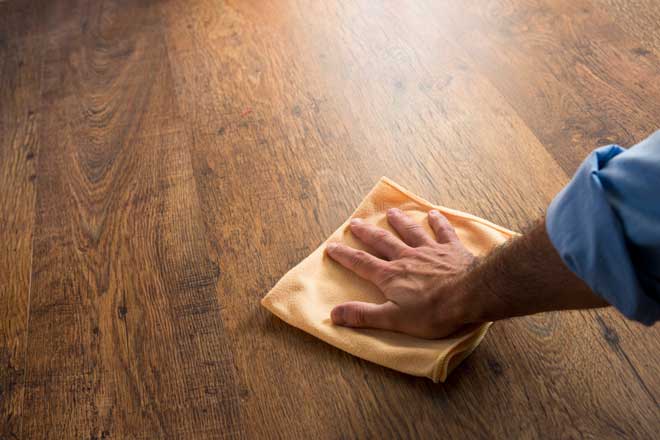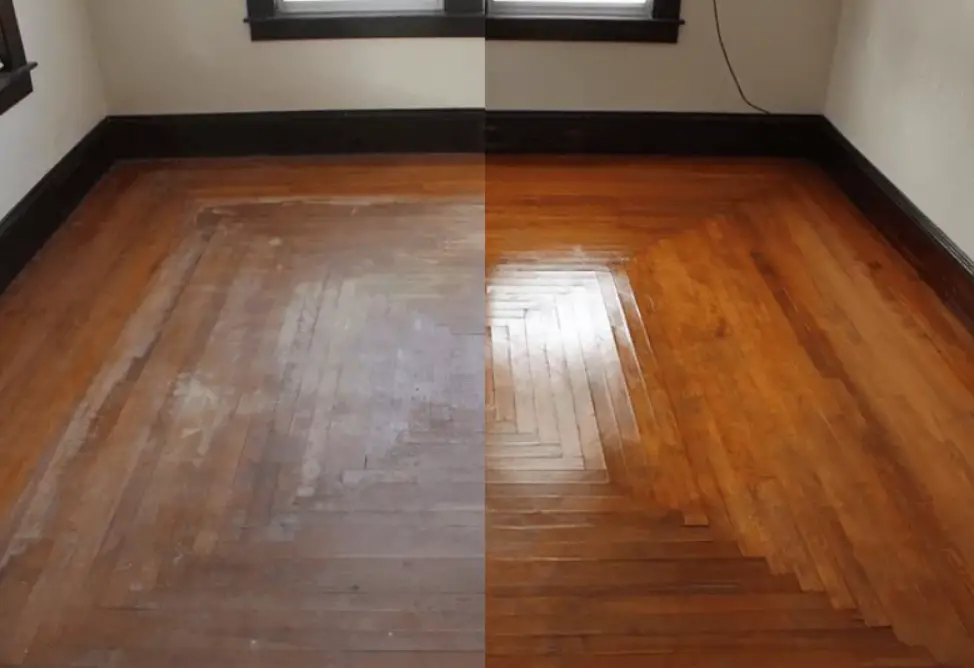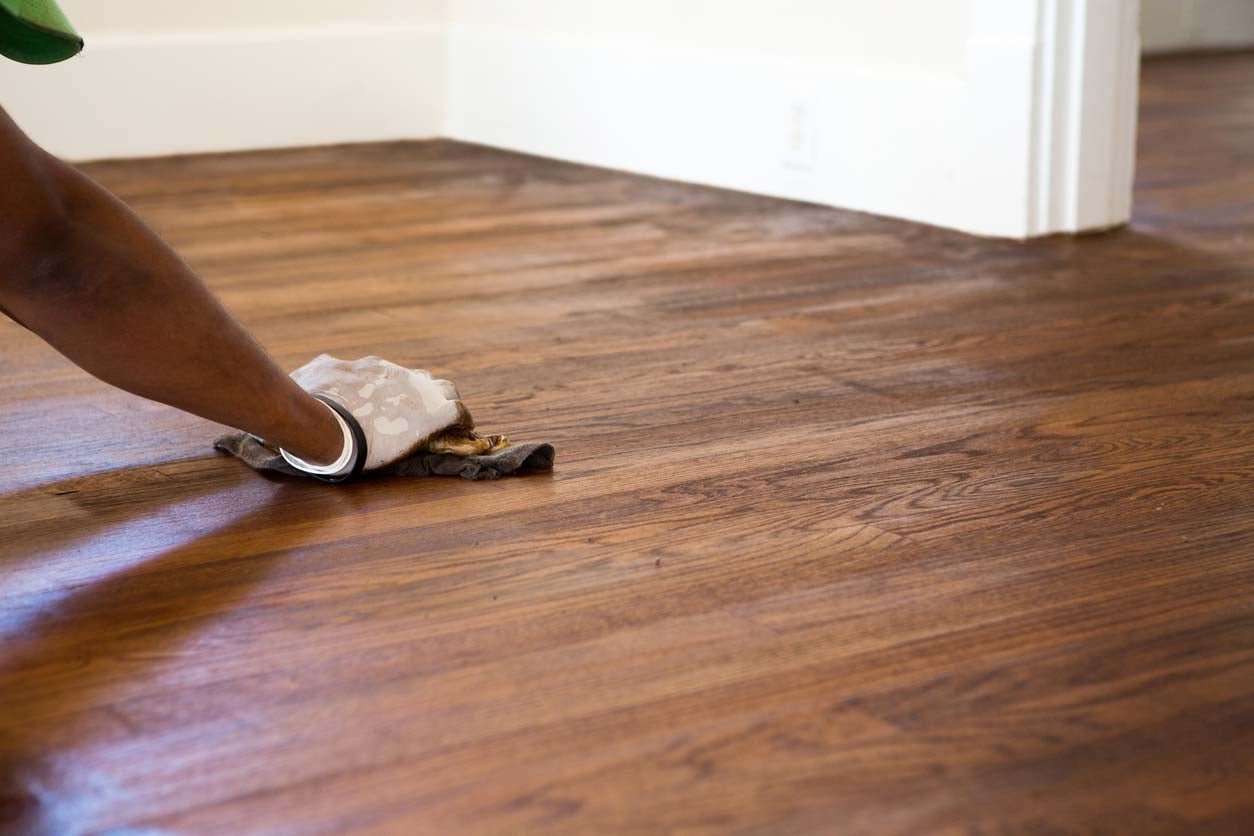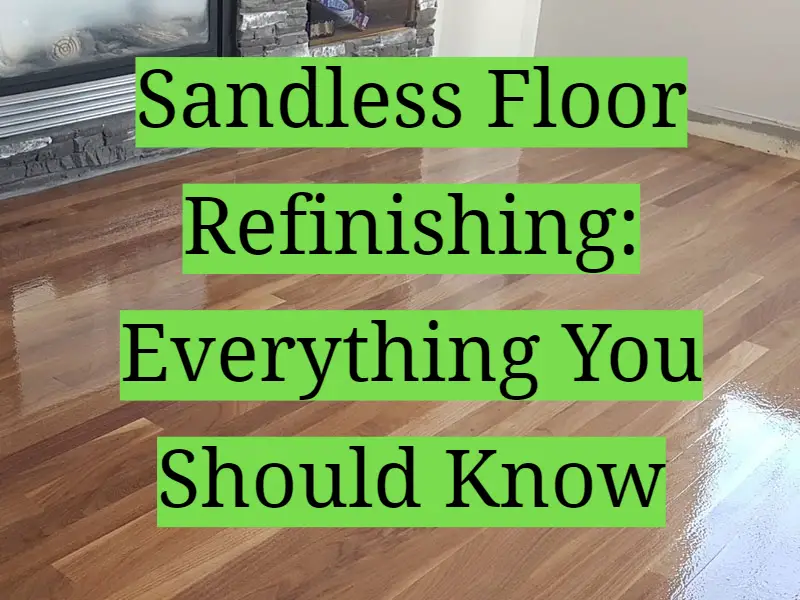If you’re considering sandless floor refinishing for your home, you’ll want to read this first. We’ll talk about the pros and cons of this process so that you can make an informed decision. Keep in mind that every home is different, and what may be a pro for one person may be a con for another. So weigh all the information before deciding if sandless floor refinishing is right for you!
What Is Sandless Floor Refinishing?

Sandless floor refinishing is a process that uses a special solution to refinish hardwood floors without having to sand them down first. If you don’t want to deal with the mess and fuss that comes from sanding your floors, opting for a fresh coat of finish is a great solution! [1]
Does It Work?
Sandless floor refinishing is a fairly new process, so there’s not a lot of long-term data on it yet. However, most people who have used it report being happy with the results. Keep in mind that this is not a one-size-fits-all solution; it works best on well-maintained hardwood floors with little wear and tear.
When Sandless Makes Sense?
If you’re trying to avoid the mess and hassle of sanding your floors, or if you’re worried about damaging them, sandless refinishing may be a good option for you. This method is also generally much faster than traditional sanding, so it can be a good choice if you’re short on time.
Sandless floor refinishing can be a great option if you have hardwood floors that are in good condition and just need a fresh coat of finish. It’s important to note that this method won’t work on all floors, and it’s not suitable for floors that are heavily damaged or worn. If you’re unsure whether sandless refinishing is right for your floors, talk to a professional flooring contractor. They can assess your floors and give you advice on the best way to refinish them.
Pros Of Sandless Floor Refinishing
Sandless floor refinishing is a huge time saver. If you have ever refinished floors the traditional way, you know that sanding is by far the most time-consuming part of the process. With sandless refinishing, that step is eliminated, which means your floors will be ready to use much sooner.

Another advantage of sandless refinishing is that it leaves your floors looking natural. Traditional floor refinishing involves sanding down to bare wood, which can give your floors an artificial look. Sandless floor refinishing products penetrate into the existing finish and bond with it, so your finished product looks more like a fresh coat of paint than a completely new floor.
Finally, sandless floor refinishing is much less messy than traditional refinishing methods. There is no sanding dust to clean up, and the products used for sandless refinishing are much less toxic than those used for traditional refinishing. [2]
Cons Of Sandless Floor Refinishing
While sandless floor refinishing has a lot of advantages, there are also some disadvantages that you should know about before you decide whether or not to go with this option. One of the biggest cons is that it’s not as durable as traditional methods. This means that it won’t last as long and you’ll probably have to refinish your floors more often.
Additionally, it’s not always possible to get the same results with sandless floor refinishing that you would with traditional methods. If you’re looking for a perfect finish, you might be disappointed. Finally, sandless floor refinishing can be more expensive than other options.
If you’re considering sandless floor refinishing, weigh the pros and cons carefully to make sure it’s the right choice for you.
How to Make a Sandless Floor Refinishing: Steps to Follow
Refinishing your floors can be a daunting task, especially if you have never done it before. There are so many different products and methods available that it can be hard to know where to start. One popular method is sandless floor refinishing, also known as no-sanding floor refinishing. This method has its pros and cons, which we will explore in this blog post.
While sandless floor refinishing and traditional methods both have their pros, sandless is much less messy. There is no need to rent expensive equipment or deal with the dust and debris that comes with sanding. Sandless floor refinishing also takes less time than traditional methods, so you can enjoy your newly refinished floors sooner.
If you are considering sandless floor refinishing, there are a few things you should keep in mind. First, make sure that your floors are compatible with the products you will be using.
If you are looking for a quick and easy way to refinish your floors, sandless floor refinishing may be the right option for you. Keep in mind that there are some disadvantages to this method, but overall it is a less messy and time-consuming option that can give you beautiful results. [3]
How Long Will The Process Take?

The entire process of sandless floor refinishing can be completed in as little as one day. This is a huge benefit when compared to the traditional method of floor refinishing, which can take up to four days. In addition, there is no need to wait for the floors to cure before they can be used, as is the case with traditional methods. [4]
How Much Dust Will I Be Cleaning Up?
Sandless floor refinishing creates very little dust, so you can relax and enjoy the process. This means that you won’t have to do a lot of cleaning up afterwards. However, it’s important to note that some dust will be created.
So, if you’re someone who hates cleaning up after projects, sandless floor refinishing might not be the best option for you.
How Will My Floors Look?
This is a difficult question to answer because it depends on a few factors. The type of floor you have, the condition of your floors, and the person doing the sandless refinishing will all play a role in how your floors look afterwards.
Generally speaking, sandless floor refinishing will leave your floors looking shiny and new. However, if you have very old or damaged floors, they may not look as good as you hope.
The best way to find out how sandless floor refinishing will work for your specific situation is to talk to a professional about it.
How Much Will This Cost?
The cost of sandless floor refinishing varies depending on a few factors. The size of your home, the condition of your floors, and the company you hire will all play a role in how much you’ll end up paying.

Generally speaking, sandless floor refinishing is more expensive than traditional methods. However, it’s important to remember that you won’t have to pay for anything else afterwards. There are no extra costs associated with this type of refinishing.
How Long Does It Last?
Sandless floor refinishing is designed to last for a long time. In most cases, it will last for several years before you need to have it done again.
However, the exact amount of time it lasts will depend on a few factors. The type of floors you have, how often they’re used, and how well they’re taken care of will all play a role in how long the refinishing lasts.
If you take good care of your floors and don’t use them too much, sandless floor refinishing can last for many years. [5]
How Do You Clean Sandless Floors?
Cleaning sandless floors is the same as cleaning any other type of floor. You can use a vacuum, mop, or anything else you would normally use.
The only thing you need to be careful of is using too much water. If you use too much water, it can damage the finish and shorten the lifespan of the refinishing.
Other than that, there’s nothing special you need to do to clean sandless floors. Just treat them like you would any other type of floor. [6]
Is It Safe?
Many people are concerned about the safety of sandless floor refinishing, especially when it comes to children and pets. Although the chemicals used in the process are strong, they are not known to be harmful if used as directed. In fact, many people choose this method of refinishing because it is less likely to cause health problems than traditional methods that use sanding machines.
FAQ
What is dust free floor sanding?
Dust free floor sanding is a process of refinishing your hardwood floors without creating any dust. This is done by using a special machine that has a dust containment system. The machine grinds down the old finish and exposes the bare wood. A new finish is then applied to the floors.
What are the benefits of dust free floor sanding?
There are several benefits to dust free floor sanding. The biggest benefit is that it eliminates the health risks associated with breathing in dust particles. Dust free floor sanding also eliminates the need for cleanup after the job is completed. And, it provides a much more consistent finish than traditional methods of refinishing hardwood floors.
What are the drawbacks of dust free floor sanding?

The biggest drawback of dust free floor sanding is the cost. The machines used to do this type of work are very expensive and the process itself can be time consuming. Additionally, if your floors are not in good condition, the results of dust free floor sanding may not be as impressive as you would like.
How do you restore hardwood floors without sanding?
If you want to restore your hardwood floors without sanding, you can use a process called screen and recoat. This process involves lightly screening the floors to remove any dirt and debris. A new coat of finish is then applied to the floors. Screen and recoat is not as effective as sanding in terms of removing scratches and stains, but it is much less invasive and can be done in a fraction of the time.
Is dustless sanding worth it?
Whether or not dustless sanding is worth it depends on your specific situation. If you are concerned about the health risks associated with dust, then dustless sanding may be a good option for you. However, if you are more concerned about the cost and time involved, then traditional methods of refinishing hardwood floors may be a better option.
What is the best way to clean hardwood floors?
The best way to clean hardwood floors depends on the type of finish that has been applied to the floors. If you have a polyurethane finish, you should use a damp mop or cloth to avoid damaging the finish. If you have an oil-based finish, you can use a vacuum cleaner with a soft brush attachment. If you have a wax finish, you should use a soft cloth or mop to avoid scratching the floors.
Is it cheaper to refinish or replace hardwood floors?
The cost of refinishing or replacing hardwood floors depends on the condition of the floors and the type of finish that you want to apply. In general, it is cheaper to refinish hardwood floors than it is to replace them.
What are the steps to refinish hardwood floors?
The steps to refinish hardwood floors are:
- Remove all furniture from the room.
- Vacuum the floor to remove all dirt and debris.
- Sand the floor with a power sander or by hand.
- Apply a new finish to the floor.
How long does it take to refinish hardwood floors?
The amount of time it takes to refinish hardwood floors varies depending on the size of the room and the condition of the floors. In general, it takes about two to four days to refinish hardwood floors.
How often should hardwood floors be refinished?
The frequency with which you should refinish your hardwood floors depends on the type of finish that has been applied to the floors. If you have a polyurethane finish, you should refinish your floors every three to five years. If you have an oil-based finish, you can refinish your floors every five to seven years.
What are the signs that hardwood floors need to be refinished?
There are several signs that indicate that hardwood floors need to be refinished. The most obvious sign is when the finish starts to wear off and the wood becomes dull. Other signs include:
- Scratches in the finish.
- Stains in the finish.
- Gaps between the boards.
- Cracks in the boards.
Can hardwood floors be refinished without sanding?
Yes, hardwood floors can be refinished without sanding; however, the results will not be as good as if you had sanded the floors first. Screen and recoat is a process that can be used to refinish hardwood floors without sanding. This process involves lightly screening the floors to remove any dirt and debris. A new coat of finish is then applied to the floors. Screen and recoat is not as effective as sanding in terms of removing scratches and stains, but it is much less invasive and can be done in a fraction of the time.
Does buffing floors create dust?
Yes, buffing floors does create dust; however, the amount of dust created is much less than if you were to sand the floors.
What are some alternatives to sanding hardwood floors?
Some alternatives to sanding hardwood floors include:
- Screen and recoat
- Buffing
- Refinishing without sanding
- Replacing the floor altogether.
You should consult with a professional to determine which option is best for your specific situation.
How much does sanding and refinishing cost?
The cost of sanding and refinishing hardwood floors varies depending on the size of the room and the condition of the floors. In general, it costs about $0.50 to $0.70 per square foot to refinish hardwood floors.
Useful Video: KY Farmhouse Wood Floors Refinished by “Sandless” Method!
Conclusion
Sanding your floors can be a dusty, messy process. If you choose not to sand, make sure you find a reputable company that specializes in sandless floor refinishing. This method uses special equipment and techniques to clean and refinish your floors without all the dust and mess.
If you’re looking for a durable, long-lasting finish, staining your hardwood floors is a great option. It’s also a good way to change the color of your floors without having to sand them. Keep in mind that stain can be difficult to remove, so be sure to choose a color you’re happy with.
If you have any questions about hardwood floor refinishing, feel free to contact us today. We’re always happy to help! Thank you for reading! We hope this article was helpful.
References
- https://www.homereference.net/sandless-floor-refinishing/
- https://elitehardwoodflooring.com/dustless-sanding/
- https://www.thisoldhouse.com/flooring/21016483/how-to-refinish-wood-floors-without-sanding
- https://sirfloor.com/sandless-refinishing
- https://www.floorcraftsanding.com/blog/sandless-refinishing-too-good-true/
- https://www.mrsandless.com/faqs.php














Leave a Reply